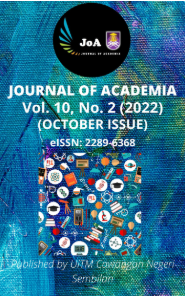INFLUENCE OF HYDROCHLORIC ACID AGAINST FOOD-GRADE STEEL SUS304 AND ITS CORROSION IMPACT
Keywords:
Corrosion, Immersion test, Weight loss, Stainless steel, Thin oxideAbstract
This study aims to investigate the progress of corrosion rate on stainless steel (SUS304) in
hydrochloric acid (HCl) as exposed for 8 days. The HCl as a corrosive medium was used at pH 2
and pH 5. The evaluation of corrosion rate was done through weight loss measurement. Morphology
and structure of metal specimens were characterized by optical microscope before and after
immersion test. The results showed that the corrosion rates were increased significantly within 4
days of immersion. The corrosion rate in pH 2 reveals the highest values at 0.020 mm/y. While in
pH 5, the rate of corrosion exhibits moderate value ranging from 0.006-0.011 mm/y. The corrosion
behavior of the stainless steel coupon was influenced by the duration of exposure in the HCl medium.
The concentration of hydrogen cations and aggressiveness of chloride anion in the corrosive medium
has been associated with corrosion.
References
Abdel-rahman, N. A. (2015). Tin-Plate Corrosion in Canned Foods. Journal of Global Biosciences, 4(7), 2966
http://mutagens.co.in. Ait Albrimi, Y., Ait Addi, A., Douch, J., Souto, R. M., & Hamdani, M. (2015). Inhibition of the pitting corrosion
of 304 stainless steel in 0.5M hydrochloric acid solution by heptamolybdate ions. Corrosion Science, 90, 522
https://doi.org/10.1016/j.corsci.2014.10.023
Ansari, F. A., Siddiqui, Y. S., & Quraishi, M. A. (2019). Corrosion of tin can and its inhibition: A review.
International Journal of Corrosion and Scale Inhibition, 8(4), 816–834. https://doi.org/10.17675/2305-6894
-8-4-3
Anthony, U., Ikenna, M., Ufuma, O. B., & Ezemuo, D. T. (2016). Corrosion Rates and its Impact on Mild Steel
in Some Selected Environments. Journal of Scientific and Engineering Research, 3(1), 34–43.
http://jsaer.com/download/vol-3-iss-1-2016/JSAER2016-03-01-34-43.pdf
ASTM G 31-72. (1985). Standard Practice for Laboratory Immersion Corrosion Testing of Metals. ASTM
International, Reapproved 2004, 1–8.
ASTM G1-90. (1999). Standard Practice for Preparing, Cleaning, and Evaluation Corrosion Test Specimens.
ASTM International, Reapproved 1999, 15–21.
Bard, & Stratmann. (2003). Encyclopedia of Electrochemistry, Corrosion and Oxide Films. Wiley-VCH Verlag,
Weinhem. https://doi.org/10.1179/000705968798326370
Bintsis,
T.
(2017).
Foodborne
https://doi.org/10.3934/microbiol.2017.3.529
pathogens.
AIMS
Microbiology,
(3),
–563.
Dalipi, R., Borgese, L., Casaroli, A., Boniardi, M., Fittschen, U., Tsuji, K., & Depero, L. E. (2016). Study of metal
release from stainless steels in simulated food contact by means of total reflection X-ray fluorescence. Journal of
Food Engineering, 173, 85–91. https://doi.org/10.1016/j.jfoodeng.2015.10.045
Deshwal, G. K., & Panjagari, N. R. (2020). Review on metal packaging: materials, forms, food applications, safety
and recyclability. Journal of Food Science and Technology, 57(7), 2377–2392. https://doi.org/10.1007/s13197
-04172-z
Eyu, G. D., Will, G., Dekkers, W., & Macleod, J. (2016). Effect of Dissolved Oxygen and Immersion Time on the
Corrosion Behaviour of Mild Steel in Bicarbonate / Chloride Solution. Materials, 9(748), 1–18.
https://doi.org/10.3390/ma9090748
Oldring, K.T. P., & Nehring, U. (2007). Packing Materials - Metal Packing for Foodstuffs. In International Life
Sciences Institute. https://ilsi.eu/wp-content/uploads/sites/3/2016/06/R2007Pac_Mat.pdf
Kamaraj, A., Erning, J. W., Reimann, S., & Ahrens, A. (2019). Susceptibility of 304 stainless steel to crevice
corrosion in electrochemically active fluids. NACE - International Corrosion Conference Series, 2019-March(4),
–435. https://doi.org/10.5006/3324 Loto, R. T. (2017). Study of the corrosion resistance of type 304L and 316 austenitic stainless steels in acid
chloride solution. Oriental Journal of Chemistry, 33(3), 1090–1096. https://doi.org/10.13005/ojc/330304
May, M. (2016). Corrosion behavior of mild steel immersed in different concentrations of NaCl solutions. Journal
of Sebha University, 15(January 2016), pp 1-12.
Mazinanian, N., Herting, G., Odnevall Wallinder, I., & Hedberg, Y. (2016). Metal release and corrosion resistance
of different stainless steel grades in simulated food contact. Corrosion, 72(6), 775–790.
https://doi.org/10.5006/2057 Ofoegbu, S. U. (2021). Comparative gravimetric studies on carbon steel corrosion in selected fruit juices and
acidic chloride media (Hcl) at different ph. Materials, 14(16). https://doi.org/10.3390/ma14164755.
Osman, M. M. (2001). Corrosion inhibition of aluminium-brass in 3.5% NaCl solution and sea water. Materials
Chemistry and Physics, 71(1), 12–16. https://doi.org/10.1016/S0254-0584(00)00510-1
Partington, E. (2006). Stainless Steel in the Food and Beverage Industry. In Materials and Applications Series (1st
editio, Vol. 7, Issue 7). Euro Inox.
Rahayu, E. F., & Asmorowati, D. S. (2019). Review of metal corrosion on food cans. Journal of Physics:
Conference Series, 1321(2). https://doi.org/10.1088/1742-6596/1321/2/022037
Reis LM, Duarte LF, Souza AG, Garcia EM, Melo JOF, Taroco CG, & Taroco HA. (2018). Electrochemical
corrosion study in tinplate can of green corn. Integrative Food, Nutrition and Metabolism, 5(5), 1–5.
https://doi.org/10.15761/ifnm.1000231
Saefuloh, I., Kanani, N., Ramadhan, F. G., Rukmayadi, Y., Yusuf, Y., Abdullah, S., & Susilo, S. (2020). The Study
of Corrosion Behavior and Hardness of AISI Stainless Steel 304 in Concentration of Chloride Acid Solution and
Temperature Variations. Journal of Physics: Conference Series, 1477(5). https://doi.org/10.1088/1742
/1477/5/052058
Sastri, V. S., Ghali, E., & Elboujdaini, M. (2007). Corrosion Prevention and Protection: Practical Solutions. In
Corrosion
Prevention
and Protection: Practical Solutions. John Wiley & Sons Ltd.
https://doi.org/10.1002/9780470024546 Satpati, S., Suhasaria, A., Ghosal, S., Saha, A., Dey, S., & Sukul, D. (2021). Amino acid and cinnamaldehyde
conjugated Schiff bases as proficient corrosion inhibitors for mild steel in 1 M HCl at higher temperature and
prolonged exposure: Detailed electrochemical, adsorption and theoretical study. Journal of Molecular Liquids,
, 115077. https://doi.org/10.1016/j.molliq.2020.115077
Singh, A., Singh, V. K., & Quraishi, M. A. (2010). Aqueous extract of kalmegh (andrographis paniculata) leaves
as green inhibitor for mild steel in hydrochloric acid solution. International Journal of Corrosion, 2010.
https://doi.org/10.1155/2010/275983
Talebian, M., Raeissi, K., Atapour, M., Fernández-Pérez, B. M., Betancor-Abreu, A., Llorente, I., Fajardo, S.,
Salarvand, Z., Meghdadi, S., Amirnasr, M., & Souto, R. M. (2019). Pitting corrosion inhibition of 304 stainless
steel in NaCl solution by three newly synthesized carboxylic Schiff bases. Corrosion Science, 160(March),
https://doi.org/10.1016/j.corsci.2019.108130
Wade, S. A., & Lizama, Y. (2015). Clarke’s solution cleaning used for corrosion product removal: Effects on
carbon steel substrate. Australasian Corrosion Association Annual Conference: Corrosion and Prevention 2015,
ACA 2015, November.
Zaffora, A., Di Franco, F., & Santamaria, M. (2021). Corrosion of stainless steel in food and pharmaceutical
industry. Current Opinion in Electrochemistry, 29, 100760. https://doi.org/10.1016/j.coelec.2021.100760
Downloads
Published
Issue
Section
License
Copyright (c) 2022 Journal of Academia

This work is licensed under a Creative Commons Attribution-NonCommercial-NoDerivatives 4.0 International License.












